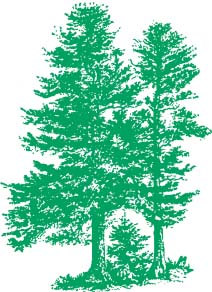In the most heavily impacted areas, the rates at which plant and animal species may be required to shift their ranges in response to global warming in the next 100 years may be as much as ten times faster than at the end of the last ice age. Unusually high migration rates are likely to affect more than 18,000 square miles of habitats (an area larger than Denmark) in Vermont, Maine, New Hampshire and New York, threatening some species with local extinction.
Range changes brought about by global warming and climatic disruption are expected to change the character of the forests of northern New England and upstate New York. Climate models predict that in the longer term global warming will eventually transform the conifer forest of northern New England into the type of forest now found farther south – either the deciduous forest of the Mid-Atlantic States, or the mixed forests characteristic of southern New England.
• The conditions that currently support northern hardwood forests will shift up to 300 miles north during the next 100 years, causing the loss of these forests over much of the landscape. The distributions of white spruce, black spruce, red spruce, balsam fir and other species of cool climates will move north and these trees are likely to disappear from most of their current ranges in the Northeastern United States. If disturbances such as fire or storms increase as has been predicted by some scientists, this would hasten the decline.
• Current modeling forecasts predict that maple sugar trees eventually would be completely eliminated as a regionally important species in the northeastern United States. Even where sugar maples are able to persist, changes in the freeze/thaw cycle are expected to reduce the quantity of syrup harvested. Maple syrup production is worth approximately $20 million annually in New England.
• Milder winters are expected to increase the vulnerability of commercial forests to insect pests including eastern spruce budworm, gypsy moth and pine bark beetle. The hemlock wooly adelgid is also likely to be able to move northwards in New York and into Maine, New Hampshire and Vermont.
• The increased frequency or severity of droughts projected by some climate models would adversely affect the health of many forest species. The region’s magnificent stands of birch and beech are particularly vulnerable. .
• Higher temperatures and more frequent droughts could be accompanied by an increase in forest fires. As a result, the number of early successional and more cosmopolitan species (such as red maple, gray birch and aspen) may increase in the forests at the expense of climax species. This would also help hasten the northward spread of southern species like oak and hickory.
• Warming temperatures could bring about an increase in the frequency of massive ice storms. In 1998 such a storm damaged more than 17 million acres of forests. Hardwood species are the most vulnerable to ice damage .
• Higher summer temperatures will contribute to greater ground-level ozone formation with the likely effect of reducing forest productivity and harming commercial tree species like red spruce and white pine. Ozone impacts are expected to be worst in southern New York and central and southern New England.
• Climate change may act in concert with other environmental stresses, including acid rain, ozone pollution, pests and drought, to reduce the productivity of forests.
The above information is from the fact sheet on Climate Change and the Northern Forest produced by Clean Air-Cool Planet, a New England based non-profit organization involved in finding and promoting solutions to global warming. The full fact sheet can be found at http://www.cleanair-coolplanet.org/information/factsheets.php. This fact sheet is based on the report Global Warming and Terrestrial Biodiversity Decline by Jay Malcolm and Adam Markham, World Wildlife Fund. 2000.
